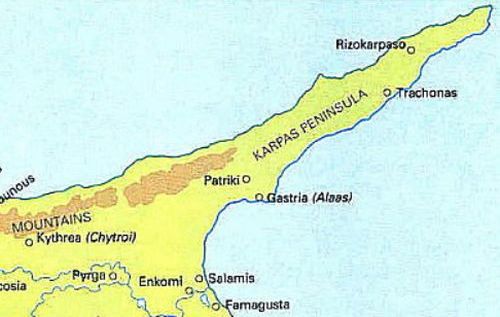The Implications
Following the initial July 1974 invasion and during the August advance of Turkish forces to the east and west, a large number of Greek Cypriots abandoned their homes and fled south. A notable exception was several hundred Greek Cypriot residents of Kyrenia & Belapais who were determined to stay.
(Note: The Kyrenia residents were incarcerated in the Dome Hotel)
The same decision was made by very small numbers of Greek Cypriots in other locations. However, a significant Greek Cypriot enclave developed in the Karpas (the 'pan handle') when the peninsula was cut off by Turkish troops thus preventing the Greek Cypriot inhabitants from fleeing to the south.

In areas well away from the fighting and those villages that were close to the Turkish line of advance, the Turkish Cypriots found themselves in a very precarious position, 'floating' in a sea of anti-Turkish sentiment which, at times, was murderous.
A number of Turkish Cypriot villages in the south immediately surrendered, gave up their weapons and were not attacked.
Other villages, who initially refused to give up their weapons, were attacked and quickly overrun by Greek Cypriot forces.
Many of the violent actions recorded against Turkish Cypriot villages were blamed on groups of well armed Greek Cypriot irregulars.
Violent actions against Greek Cypriots in villages that were in the conflict area or left isolated were blamed on Turkish Cypriot militia groups and the Turkish army. The diary of a British airline pilot living near the invasion area records the indiscipine and aggressiveness of many (but not all) Turkish soldiers.
Especially in the Paphos District, some younger Turkish Cypriot villagers fled over the mountains to the occupied north, some fled to the SBAs but many stayed where they were (although their villages were often surrounded with movement severely restricted). Those caught trying to reach the Turkish area were arrested and returned to their village.
Five Turkish Cypriot villages in the Paphos area successfully defended themselves and became important strongholds for Turkish Cypriot Fighters.
Episkopi was the closest SBA and, initially, a large number of Turkish Cypriot refugees congregated in the camp's shopping area known as 'Dodge City'.
Many spent the night in the Astra.....the camp's open-air cinema.
However, a decision was quickly made to set up a camp in the sport fields of 'Happy Valley'.



The growing Turkish Cypriot refugee camp in Episkopi's Happy Valley within the Western Sovereign Base Area (WSBA)
Virtually all the refugees in this camp came from isolated Turkish Cypriot villages located near to the base
Note: A small number of Greek Cypriots who sought the safety of the WSBA were accommodated in a small camp on Curium Beach
Realising that Happy Valley could not sustain the effort of housing so many refugees over a long period, plans were made for a custom-built camp to be erected at Paramali Station, some 2-3 miles away (often referred to as Long Beach Camp). On the 5th August 1974, from the peak of 5698 refugees,1500 members of selected villages were moved. The new camp had shower and cooking facilities in addition to field lavatories, a medical centre, tannoy system and police control point.

The first movement of Turkish Cypriot refugees from Happy Valley to Paramali Station (Long Beach)
On the 14th September 1974 a second camp was opened called Paramali Forest (an area north of the Limassol-Paphos road).

Eventually, the existing camp in Happy Valley was emptied and all the refugees were moved to one of the two Paramali camps
Click the image or this link for a larger version of the maps
All the vehicles (buses, trucks, tractors, vans, cars and motorcycles) that had been used by the refugees to reach the safety of the SBA were stored in a compound in Episkopi Camp
Greek Cypriots from towns and villages in the north fled the fighting and moved south to a number of refugee camps that were set up by the Cyprus Govenment and international aid agencies.
The more fortunate were able to share with relatives who were already living in the south.


This small Greek Cypriot refugee camp was set up in a public space near Nicosia

Other Greek Cypriot refugees camps were much larger............this image is at Kolossi

A Greek Cypriot refugee camp in the Larnaca area

Following the speedy Turkish advance towards Famagusta between 14-16th August, a large number of Greek Cypriot refugees took shelter in Achna Forest inside the ESBA
The animation shows images of this camp which, at its maximum size, sheltered over 6,000 refugees

The scale of the refugee issue detailed in a US House of Representatives special study report